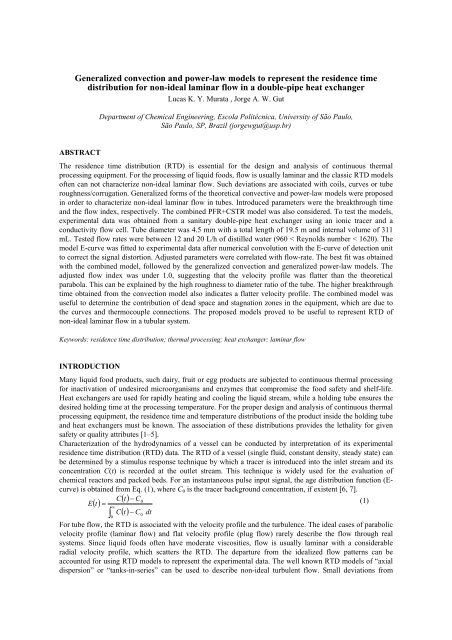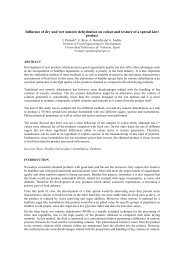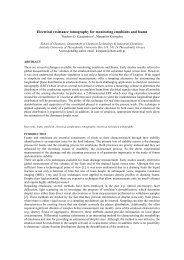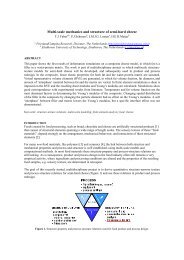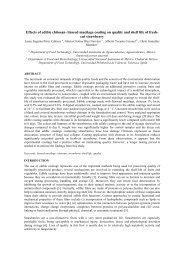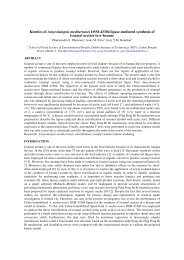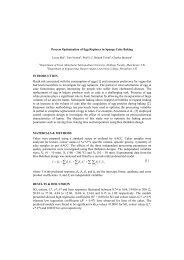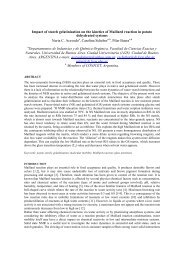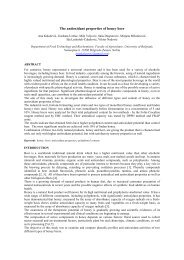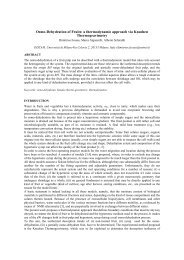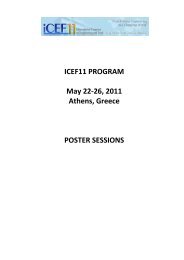Generalized convection and power-law models to represent ... - USP
Generalized convection and power-law models to represent ... - USP
Generalized convection and power-law models to represent ... - USP
You also want an ePaper? Increase the reach of your titles
YUMPU automatically turns print PDFs into web optimized ePapers that Google loves.
<strong>Generalized</strong> <strong>convection</strong> <strong>and</strong> <strong>power</strong>-<strong>law</strong> <strong>models</strong> <strong>to</strong> <strong>represent</strong> the residence time<br />
distribution for non-ideal laminar flow in a double-pipe heat exchanger<br />
Lucas K. Y. Murata , Jorge A. W. Gut<br />
Department of Chemical Engineering, Escola Politécnica, University of São Paulo,<br />
São Paulo, SP, Brazil (jorgewgut@usp.br)<br />
ABSTRACT<br />
The residence time distribution (RTD) is essential for the design <strong>and</strong> analysis of continuous thermal<br />
processing equipment. For the processing of liquid foods, flow is usually laminar <strong>and</strong> the classic RTD <strong>models</strong><br />
often can not characterize non-ideal laminar flow. Such deviations are associated with coils, curves or tube<br />
roughness/corrugation. <strong>Generalized</strong> forms of the theoretical convective <strong>and</strong> <strong>power</strong>-<strong>law</strong> <strong>models</strong> were proposed<br />
in order <strong>to</strong> characterize non-ideal laminar flow in tubes. Introduced parameters were the breakthrough time<br />
<strong>and</strong> the flow index, respectively. The combined PFR+CSTR model was also considered. To test the <strong>models</strong>,<br />
experimental data was obtained from a sanitary double-pipe heat exchanger using an ionic tracer <strong>and</strong> a<br />
conductivity flow cell. Tube diameter was 4.5 mm with a <strong>to</strong>tal length of 19.5 m <strong>and</strong> internal volume of 311<br />
mL. Tested flow rates were between 12 <strong>and</strong> 20 L/h of distilled water (960 < Reynolds number < 1620). The<br />
model E-curve was fitted <strong>to</strong> experimental data after numerical convolution with the E-curve of detection unit<br />
<strong>to</strong> correct the signal dis<strong>to</strong>rtion. Adjusted parameters were correlated with flow-rate. The best fit was obtained<br />
with the combined model, followed by the generalized <strong>convection</strong> <strong>and</strong> generalized <strong>power</strong>-<strong>law</strong> <strong>models</strong>. The<br />
adjusted flow index was under 1.0, suggesting that the velocity profile was flatter than the theoretical<br />
parabola. This can be explained by the high roughness <strong>to</strong> diameter ratio of the tube. The higher breakthrough<br />
time obtained from the <strong>convection</strong> model also indicates a flatter velocity profile. The combined model was<br />
useful <strong>to</strong> determine the contribution of dead space <strong>and</strong> stagnation zones in the equipment, which are due <strong>to</strong><br />
the curves <strong>and</strong> thermocouple connections. The proposed <strong>models</strong> proved <strong>to</strong> be useful <strong>to</strong> <strong>represent</strong> RTD of<br />
non-ideal laminar flow in a tubular system.<br />
Keywords: residence time distribution; thermal processing; heat exchanger; laminar flow<br />
INTRODUCTION<br />
Many liquid food products, such dairy, fruit or egg products are subjected <strong>to</strong> continuous thermal processing<br />
for inactivation of undesired microorganisms <strong>and</strong> enzymes that compromise the food safety <strong>and</strong> shelf-life.<br />
Heat exchangers are used for rapidly heating <strong>and</strong> cooling the liquid stream, while a holding tube ensures the<br />
desired holding time at the processing temperature. For the proper design <strong>and</strong> analysis of continuous thermal<br />
processing equipment, the residence time <strong>and</strong> temperature distributions of the product inside the holding tube<br />
<strong>and</strong> heat exchangers must be known. The association of these distributions provides the lethality for given<br />
safety or quality attributes [1–5].<br />
Characterization of the hydrodynamics of a vessel can be conducted by interpretation of its experimental<br />
residence time distribution (RTD) data. The RTD of a vessel (single fluid, constant density, steady state) can<br />
be determined by a stimulus response technique by which a tracer is introduced in<strong>to</strong> the inlet stream <strong>and</strong> its<br />
concentration C(t) is recorded at the outlet stream. This technique is widely used for the evaluation of<br />
chemical reac<strong>to</strong>rs <strong>and</strong> packed beds. For an instantaneous pulse input signal, the age distribution function (Ecurve)<br />
is obtained from Eq. (1), where C 0 is the tracer background concentration, if existent [6, 7].<br />
C<br />
<br />
t C0<br />
E t <br />
(1)<br />
<br />
C<br />
t C0<br />
dt<br />
0<br />
For tube flow, the RTD is associated with the velocity profile <strong>and</strong> the turbulence. The ideal cases of parabolic<br />
velocity profile (laminar flow) <strong>and</strong> flat velocity profile (plug flow) rarely describe the flow through real<br />
systems. Since liquid foods often have moderate viscosities, flow is usually laminar with a considerable<br />
radial velocity profile, which scatters the RTD. The departure from the idealized flow patterns can be<br />
accounted for using RTD <strong>models</strong> <strong>to</strong> <strong>represent</strong> the experimental data. The well known RTD <strong>models</strong> of “axial<br />
dispersion” or “tanks-in-series” can be used <strong>to</strong> describe non-ideal turbulent flow. Small deviations from
laminar flow are more difficult <strong>to</strong> <strong>represent</strong> since the RTD curve is asymmetric. Deviations of ideal laminar<br />
flow are associated with coils or curves <strong>and</strong> also with tube roughness or corrugation.<br />
The objective of this work is <strong>to</strong> propose generalized forms of the theoretical convective <strong>and</strong> <strong>power</strong>-<strong>law</strong> RTD<br />
<strong>models</strong> in order <strong>to</strong> characterize non-ideal laminar flow in tubes <strong>and</strong> <strong>to</strong> test these <strong>models</strong> on a sanitary doublepipe<br />
heat exchanger.<br />
MATERIALS & METHODS<br />
RTD Models<br />
The theoretical E-curve associated with the parabolic radial velocity profile of laminar tube flow is given by<br />
Eq. (2) that is known as the “<strong>convection</strong> model”. Variable is the mean residence time, which is calculated<br />
as V/Q (volume/flow-rate). Likewise, Eq.(3) presents the theoretical RTD curve for the tube flow of a <strong>power</strong><strong>law</strong><br />
fluid, where n is the flow index [6, 7].<br />
2<br />
1 <br />
1 <br />
E t <br />
t <br />
(2)<br />
3<br />
2 t<br />
2 <br />
n1<br />
2n<br />
2<br />
n1<br />
n 1 <br />
n 1 <br />
E t 1<br />
3<br />
3 1 <br />
3 1 t <br />
(3)<br />
n t n t <br />
3n<br />
1<br />
Non-ideal laminar flow in tubes occurs when the relative roughness of the wall interferes with the velocity<br />
profile or when the tube has curves or it is coiled. In this case, Eqs. (2) <strong>and</strong> (3) would fail <strong>to</strong> predict the RTD<br />
<strong>and</strong> an experimental study is necessary. Large deviations from ideal flow with considerable dispersion could<br />
be <strong>represent</strong>ed by the classic axial dispersion or the tanks-in-series <strong>models</strong>; however, the long tail of tracer<br />
that is characteristic of laminar flow can not be captured correctly.<br />
Since Eqs. (2) <strong>and</strong> (3) are theoretical, both can be modified by the introduction of parameters. The first<br />
parameter would be the active volume of the vessel, V active , that is associated with the measured mean<br />
residence time as V active = Q. Consequently, the dead volume of the vessel is given by V dead = V – V active . The<br />
dead volume is related <strong>to</strong> undesirable stagnation <strong>and</strong> recirculation areas.<br />
Adaptations of the <strong>convection</strong> model were previously used by other authors <strong>to</strong> describe laminar flow in<br />
helical coils <strong>and</strong> chemical reac<strong>to</strong>rs [5]. In this work, the approach is the parameterize the breakthrough time<br />
in Eq. (1) that is the minimum residence time given by ( = ½ for the ideal case). Taking in<strong>to</strong> account that<br />
the area under the E-curve must be unitary, Eq. (1) can be rewritten as Eq. (4), the “generalized <strong>convection</strong><br />
model”.<br />
1<br />
1<br />
1 <br />
E t <br />
t <br />
(4)<br />
1<br />
t<br />
t <br />
The proposed parameterization of Eq. (3) is simpler: the <strong>power</strong>-<strong>law</strong> index n is disassociated from the<br />
rheological behaviour of the liquid <strong>and</strong> turned in<strong>to</strong> a free parameter. The flow index is related <strong>to</strong> the shape of<br />
the radial velocity profile in tube flow through Eq. (5), where v b is the mean (bulk) velocity <strong>and</strong> R is the<br />
internal radius of the tube. Note that for n = 1.0 the New<strong>to</strong>nian parabolic profile is obtained. Equation (3)<br />
with free parameter n constitutes the “generalized <strong>power</strong>-<strong>law</strong> model”.<br />
n1<br />
<br />
2<br />
3n<br />
1<br />
<br />
<br />
r n<br />
n1.<br />
0<br />
r<br />
v r v 1<br />
2v<br />
1<br />
<br />
(5)<br />
b<br />
b <br />
n 1<br />
<br />
R <br />
<br />
R <br />
<br />
<br />
Besides the generalized <strong>convection</strong> <strong>and</strong> <strong>power</strong>-<strong>law</strong> <strong>models</strong>, a third RTD model is also considered in this<br />
work, which is the combined PFR+CSTR model. Its E-curve can easily model a long tail of tracer. Equation<br />
(6) provides the E-curve of the combined model, where the parameters are plug <strong>and</strong> mix (mean residence<br />
times of the plug flow <strong>and</strong> mixed flow regions). The mean residence time is = plug + mix <strong>and</strong> the active<br />
volume is obtained from V active = Q [6, 7].<br />
1 t <br />
plug<br />
<br />
<br />
E t exp<br />
<br />
t <br />
(6)<br />
plug<br />
mix<br />
mix<br />
<br />
Figure 1 presents the dimensionless E-curves (E = E) of the three <strong>models</strong> using a dimensionless time<br />
variable that is = t/.
RTD Experiments<br />
The RTD experiments were conducted on the heating section of a tubular continuous pasteurizer with<br />
nominal capacity of 20 L/h (see Figure 2). The equipment was previously used for the pasteurization of<br />
banana puree <strong>and</strong> mango puree. Tested fluid in this work was distilled water in laminar flow (flow-rate<br />
between 12 <strong>and</strong> 20 L/h with Reynolds number between 960 <strong>and</strong> 1620). The heating section was a doublepipe<br />
heat exchanger with five hairpins connected in series. The inner diameter was 4.5 mm <strong>and</strong> the <strong>to</strong>tal<br />
length was 19.5 m (including the return bends). The internal volume was 311 mL.<br />
12<br />
12<br />
10<br />
0.1<br />
<br />
0.9<br />
a<br />
10<br />
0<br />
b<br />
8<br />
0.2<br />
0.8<br />
8<br />
n<br />
0.3<br />
0.1<br />
E <br />
6<br />
0.3 0.7<br />
E <br />
6<br />
0.6<br />
4<br />
0.4 0.6<br />
0.5<br />
4<br />
2.0<br />
1.0<br />
2<br />
2<br />
<br />
E <br />
0<br />
0.0 0.5 1.0 1.5 2.0<br />
<br />
12<br />
10<br />
8<br />
6<br />
4<br />
2<br />
0.9<br />
plug<br />
0.8<br />
0.7<br />
0.6<br />
0.5<br />
0.2 0.3 0.4<br />
0.1<br />
c<br />
0<br />
0.0 0.5 1.0 1.5 2.0<br />
<br />
DTR Models:<br />
a = generalized <strong>convection</strong><br />
b = generalized <strong>power</strong>-<strong>law</strong><br />
c = combined PFR+CSTR<br />
0<br />
0.0 0.5 1.0 1.5 2.0<br />
<br />
Figure 1. Dimensionless E-curves for the RTD <strong>models</strong> considered in this work. Curves are from Eqs. (4), (3) <strong>and</strong> (6).<br />
Figure 2. Pho<strong>to</strong>graph of the pasteurizer. Cooling heat exchanger at left <strong>and</strong> heating heat exchanger at right, with the<br />
holding tube in between.<br />
Sodium chloride was used as tracer, which was detected with a conductivity meter with flow-through cell<br />
(YSI, Ohio, USA). Data acquisition frequency was 1 Hz. A low background concentration of NaCl was kept<br />
<strong>to</strong> improve the strength of the conductivity signal. A small volume of saturated NaCl solution was injected<br />
through a Tee at the entrance of the exchanger using a syringe. All experimental measurements were run in<br />
quadruplicate. The tracer concentration was calculated from the electrical conductivity <strong>and</strong> temperature data<br />
using a calibration equation [5]. The experimental values of E(t) were obtained through Eq. (1), using a<br />
trapezoidal method <strong>to</strong> evaluate the integral.
Model adjustment<br />
The RTD data from a pulse response experiment is affected by the way the tracer is injected <strong>and</strong> by how it is<br />
detected. When measuring short residence times, the efficiency of the injection <strong>and</strong> detection units is of<br />
considerable importance [8]. In order <strong>to</strong> take in<strong>to</strong> account the signal dis<strong>to</strong>rtion promoted by the detection<br />
unit, its E-curve was determined for the same flow-rate <strong>and</strong> temperature conditions of the RTD experiments<br />
<strong>and</strong> the model curve was convoluted with this E-curve before the model adjustment. The technique is<br />
described in details elsewhere [5].<br />
The two model parameters were adjusted in order <strong>to</strong> minimize the sum of squared errors of the convoluted<br />
curve. The convolution was accomplished numerically in the time domain using a time step of 0.05, 0.10 or<br />
0.20 s, depending on the time horizon. The number of discrete time points was 500. The Solver feature of<br />
Excel (Microsoft, Redmond, USA), which uses a GRG2 algorithm, was applied <strong>to</strong> minimize the error<br />
function after a good first estimate of the parameters was obtained by trial <strong>and</strong> error.<br />
RESULTS & DISCUSSION<br />
An example of E-curve fitting is presented in Figure 3 for a given experimental run. Each Et plot provides<br />
the model curve, the convoluted curve <strong>and</strong> the experimental points. The clear difference between the model<br />
curve <strong>and</strong> the convoluted curve shows that the signal dis<strong>to</strong>rtion promoted by the detection unit is significant.<br />
The experimental RTD data presented a long tail of tracer that is characteristic of laminar flow <strong>and</strong>/or<br />
stagnation areas.<br />
0.10<br />
0.08<br />
model<br />
a<br />
0.10<br />
0.08<br />
model<br />
b<br />
E (1/s)<br />
0.06<br />
0.04<br />
convolution<br />
E (1/s)<br />
0.06<br />
0.04<br />
convolution<br />
0.02<br />
experimental<br />
0.02<br />
experimental<br />
E (1/s)<br />
0.00<br />
0 20 40 60 80 100 120 140<br />
t (s)<br />
0.10<br />
0.08<br />
model<br />
0.06<br />
convolution<br />
0.04<br />
c<br />
0.00<br />
0 20 40 60 80 100 120 140<br />
t (s)<br />
DTR Models:<br />
a = generalized <strong>convection</strong><br />
b = generalized <strong>power</strong>-<strong>law</strong><br />
0.02<br />
experimental<br />
c = combined PFR+CSTR<br />
0.00<br />
0 20 40 60 80 100 120 140<br />
t (s)<br />
Figure 3. Example of RTD model adjustment for a given experimental run (Q = 16.5 L/h). The sums of squared errors on<br />
E were: a) 6.610 –4 , b) 14.110 –4 <strong>and</strong> c) 3.310 –4 .<br />
The model that provided the best fit for the considered flow-rate range was the combined PFR+CSTR model,<br />
followed by the generalized <strong>convection</strong> model <strong>and</strong> by the generalized <strong>power</strong>-<strong>law</strong> model. The means of the<br />
sum of squared errors on E were 4.410 –4 , 8.310 –4 <strong>and</strong> 14.510 –4 s –2 , respectively. The adjusted parameters<br />
are presented in Figure 4.<br />
According <strong>to</strong> Eq. (1), the theoretical breakthrough time for laminar flow is half of the mean residence time,<br />
which corresponds <strong>to</strong> = 0.5. In Figure 4a it can be seen that > 0.5 was observed with a positive effect of<br />
the flow rate. This deviation indicates the existence of secondary flow circulation that delayed the<br />
breakthrough time for laminar flow in helical coils [9, 10]. Since the exchanger have ten return bends <strong>and</strong><br />
some tees for thermocouple connection, some internal recirculation may exist.<br />
Figure 4b shows that the flow index for water was n < 1.0 that is characteristic of a pseudo-plastic fluid. The<br />
velocity profile of a pseudoplastic fluid in laminar flow is flatter than the theoretical parabola for New<strong>to</strong>nian
tube flow. The results indicate that the relative tube roughness altered the velocity profile by inducing some<br />
turbulence near the wall, which consequently made the velocity profile flatter. The return bends <strong>and</strong> tees may<br />
also have this effect locally. The negative effect of the flow-rate on n indicates a tendency <strong>to</strong>wards plug-flow<br />
with increasing flow rate.<br />
1.0<br />
1.1<br />
0.9<br />
0.8<br />
y = 1.36E-02x + 4.27E-01<br />
R 2 = 9.90E-01<br />
1.0<br />
0.9<br />
theoretical n = 1.0<br />
0.7<br />
0.8<br />
<br />
n<br />
0.6<br />
0.7<br />
0.5<br />
theoretical = 0.5<br />
0.4<br />
a<br />
0.3<br />
10 12 14 16 18 20 22<br />
Q (L/h)<br />
60<br />
0.6<br />
0.5<br />
y = -2.55E-02x + 1.14E+00<br />
R 2 = 8.18E-01<br />
0.4<br />
10 12 14 16 18 20 22<br />
110<br />
Q (L/h)<br />
b<br />
50<br />
plug-flow<br />
y = 7.08E+02x -1.03E+00<br />
R 2 = 9.93E-01<br />
100<br />
90<br />
40<br />
80<br />
<strong>convection</strong><br />
<strong>power</strong>-<strong>law</strong><br />
(s)<br />
30<br />
(s)<br />
70<br />
20<br />
10<br />
mixed-flow<br />
y = 1.26E+03x -1.58E+00<br />
R 2 = 9.92E-01<br />
c<br />
60<br />
50<br />
40<br />
combined<br />
theoretical<br />
d<br />
0<br />
30<br />
10 12 14 16 18 20 22<br />
10 12 14 16 18 20 22<br />
Q (L/h)<br />
Q (L/h)<br />
Figure 4. Summary of the results: a) parameter of the generalized <strong>convection</strong> model; b) parameter n of the generalized<br />
<strong>power</strong>-<strong>law</strong> model; c) parameters plug <strong>and</strong> mix of the combined model (best fit in this work); d) mean residence time as<br />
predicted by the three <strong>models</strong> <strong>and</strong> theory (V/Q).<br />
0.09<br />
E (1/s)<br />
0.08<br />
0.07<br />
0.06<br />
0.05<br />
0.04<br />
0.03<br />
0.02<br />
0.01<br />
Theoretical<br />
Gen. <strong>convection</strong><br />
Gen. Power-<strong>law</strong><br />
Combined (best fit)<br />
0.00<br />
0 20 40 60 80 100 120<br />
Figure 5. Example of RTD model adjustment for a given experimental run (Q = 16.5 L/h). The sums of squared errors on<br />
E were: a) 6.610 –4 , b) 14.110 –4 <strong>and</strong> c) 3.310 –4 .<br />
t (s)
The best model fit was obtained with the combined PFR+CSTR model, whose parameters are presented in<br />
Figure 4c. For laminar flow, parameter plug is actually the breakthrough time associated with the maximum<br />
velocity at the centre of the tube. The difference between the <strong>convection</strong> <strong>and</strong> combined <strong>models</strong> resides on the<br />
shape of the descending part or the curve. As can be noticed in Figure 2, the <strong>convection</strong> model better<br />
<strong>represent</strong>ed this part of the curve.<br />
The difference between the theoretical residence time <strong>and</strong> the residence time predicted by the combined<br />
model can be seen in Figure 4d. This difference suggests that 19% of the internal volume of the exchanger is<br />
associated with stagnation <strong>and</strong> recirculation regions.<br />
Figure 5 brings the theoretical E-curve <strong>and</strong> the predictions from the adjusted RTD <strong>models</strong> for laminar flow in<br />
the double-pipe heat exchanger with a flow rate of 15 L/h. It is clear that the proposed <strong>models</strong> could capture<br />
the nonideality of the flow. The combined model provided the best fit, but the difference among the model<br />
curves in Figure 5 is rather small. The curves in Figure 5 could be combined with the temperature<br />
distribution along the exchanger in order <strong>to</strong> evaluate the distributed <strong>and</strong> integrated lethality in the heating<br />
section of the exchanger [11].<br />
CONCLUSIONS<br />
The proposed <strong>models</strong> proved <strong>to</strong> be useful <strong>to</strong> <strong>represent</strong> RTD of non-laminar flow in tubular systems, which<br />
are usually found in the continuous processing of liquid foods. The E-curve of these <strong>models</strong> can <strong>represent</strong> the<br />
tail of tracer that is inherent in laminar flow. These <strong>models</strong> can be used in practice <strong>to</strong> <strong>represent</strong> the flow<br />
patterns of tubular vessels <strong>and</strong> <strong>to</strong> diagnose deviations from non-ideal flow. Future testes will be conducted<br />
using a glycerol/water mixture, which is a New<strong>to</strong>nian viscous liquid, <strong>and</strong> a CMC solution, which is a pseudoplastic<br />
viscous fluid.<br />
ACKNOWLEDGMENTS<br />
The authors wish <strong>to</strong> thank the São Paulo State Research Fund Agency (FAPESP 2009/07934-3) <strong>and</strong> the<br />
National Council for Scientific <strong>and</strong> Technological Development (CNPq PIBIC) for financial support.<br />
REFERENCES<br />
[1] Toledo R.T. 1999. Fundamentals of Food Process Engineering. 2.ed. New York: Chapman & Hall.<br />
[2] Lewis M. & Heppell N. 2000. Continuous Thermal Processing of Foods: Pasteurization <strong>and</strong> UHT Sterilization. Aspen<br />
Publishers, Gaithersburg, USA.<br />
[3] Torres A.P. & Oliveira F.A.R. 1998. Residence Time Distribution Studies in Continuous Thermal Processing of<br />
Liquid Foods: a Review. Journal of Food Engineering, 36(1), 1–30.<br />
[4] Torres A.P., Oliveira F.A.R. & Fortuna S.P. 1998. Residence Time Distribution of Liquids in a Continuous Tubular<br />
Thermal Processing System - Part I: Relating RTD <strong>to</strong> Processing Conditions. Journal of Food Engineering, 35(2),<br />
147–163.<br />
[5] Gutierrez C.G.C.C., Dias E.F.T.S. & Gut J.A.W. 2010. Residence Time Distribution in Holding Tubes Using<br />
<strong>Generalized</strong> Convection Model <strong>and</strong> Numerical Convolution for Non-Ideal Tracer Detection. Journal of Food<br />
Engineering, 98, 248–256.<br />
[6] Fogler H.S. 2005. Elements of Chemical Reaction Engineering. 4.ed. Prentice Hall, Upper Saddle River, USA.<br />
[7] Levenspiel O. 1989. The Chemical Reac<strong>to</strong>r Ominibook. Oregon State University, USA.<br />
[8] Bur<strong>to</strong>n H. 1958. An Analysis of the Performance of an Ultra-High-Temperature Milk Sterilizing Plant: I. Introduction<br />
<strong>and</strong> Physical Measurements. Journal of Dairy Research, 25(1), 75–84.<br />
[9] Ruthven D.M. 1971. The Residence Time Distribution for Ideal Laminar Flow in a Helical Tube. Chemical<br />
Engineering Science, 26, 1113–1121.<br />
[10] Trivedi R.N. & Vasudeva K. 1974. RTD for Diffusion Free Laminar-Flow in Helical Coils. Chemical Engineering<br />
Science, 29(12), 2291–2295.<br />
[11] Rao M.A. & Loncin M. 1974. Residence Time Distribution <strong>and</strong> its Role in Continuous Pasteurization (Part II).<br />
Lebensmittel-Wissenschaft und-Technologie, 7(1), 14–17.


